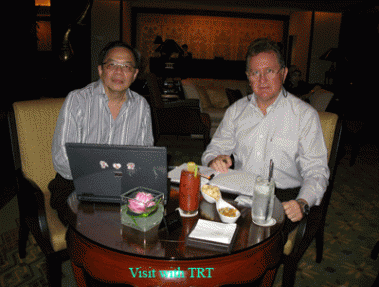Stable company in a stable growth industry, at low valuation.
Electricity consumption increases are a foregone conclusion, and so is the need for transformers.
There are lots of uncertainties when investing in companies through common stock ownership. Stock markets move up and down on sentiment, investor mood, media exaggerations, or just plain rumors and more.
This is why in my view its important to stick to good fundamentals through value investing. So called value investing in smaller cap Thai stocks prove to often be less volatile because these already trade at a considerable discount to the average Thai stock while paying far more then average in dividend yields. They also are not dependent on the winds of institutional window dressing.
If a company, say for example, pays 6-7% in annual dividends and then the stock drops to half its value, the dividend yield would increase to a huge 12-14%, not likely. Hence with high dividends there is a strong “invisible hand” which most often prevents such drop offs, unless of course the high dividend is in question.
The same cannot be said with stocks which yield far less, or even pay no dividends. No “invisible hands” are there to support it, as the high yield is absent! The best definition of any medium to long term stock investment in my view is its ability to generate high dividend income, while one awaits a move up which is impossible to time. In finance they teach you that the rational current value of any stock is only its total present value, of all future expected dividends. And while large cap stocks offer better liquidity, all so perceived important to large investors, they just don’t’ have the high dividends that my bias has, that is in finding growth companies with low p/e’s, high dividends and above average growth rates.
Above average long term growth rates.
These are the key words, as a company which grows twice as fast compared to another, should be worth 3 times more; as can be proven in finance and as makes perfectly good sense. Growing faster then average allows for future dividend increases -and so a higher current value. Deviances from this investor theme, are in the long term irrational and so mostly investor sentiment or pure momentum driven; these don’t stand the test of time, cannot be measured -and so are illogical.***
One of the things which we know will grow 6-7% per year in Thailand, just about by definition, is domestic electric consumption. It will be closer to 7% if the Thai economy booms a bit, while more like 6% per year, if the domestic economy sags. Either way, like all around the world, electric consumption here is going to grow and so likely double in total watts consumed over the next 10 to 12 years, depending on GDP growth. It is totally inconceivable that “something big changes”, which would dent this 6-7% annual growth figure by any even a small amount. Hence, this 6-7% growth rate for electric power is just about a “slam dunk” conclusion/absolute here.
Similar to USA where annual electric consumption however only grows 2-3% per year; yet it will continue to do so, not matter what! For a most convincing read on this see “Bottomless Well” by Peter Huger and Mark Mills. Here they explain that even countless energy conservations measures/methods will not dent yearly increases in electric consumption and this for decades to come. Short of a global war or an out right depression for years, electric consumption % increases will continue.
Electric energy begets more electric energy and this is true always and everywhere. Efficiency fails to curb demand because it lets more people do more things, do it faster which invariably swamps all the efficiency gains. Just like the computers did not produce the paperless office, so will efficiency gains and new technologies not reduce the need for ever more electricity.
Consider some proven facts/stat’s which USA is good at documenting we realize this wealth effect emerges all over the world, as people get richer they use more energy.
Between 1998 and year 2006, the amount of electricity that US homes used to power their consumer electronics alone, (TV, home theaters systems CER, cordless phones, computer, printers, answering machines etc..) more then doubled. (In year 2006 alone, such consumer electronics in the US ate just about 147 bill kilowatt hours of electricity. Add to all this just the hundreds of millions of mobile phone chargers and you get the picture, there are countless other examples which document this.
That’s more electricity used (consumer electronics) than was produced by all of the windmills, solar panels, and biomass to electric plants in the US that year).* Large flat screen TV’, consumer up to 4 times more electricity then the older version cathode-ray-tube models -and the newer Pentium IV computer chips uses 4-5 times more electric power then earlier versions. Just the massive computer servers around the US, doubled their electric usage between 2000 and year 2005; they are the new energy hogs, just like big old US cars used to be.
Anyway you slice or dice it, there is no way electric usage will drop or be less then the around 6-7% annual growth figure estimated for Thailand; electric usage here will grow yearly, the only question is will be it be closer to 7% (if economy doing well), or closer to 6% (another recession), with the likelihood of this growth rate being in between these 2 numbers.
For an investor, the question so then could be: how many kind of businesses do you know that have a ‘guaranteed’ high long term growth rate within such narrow 6-7% range, almost (within reason) regardless what happens to GDP growth, consumer sentiment/preferences, or changing technologies and tastes. No matter which way the economic wind blows or how technology or the consumer changes, electricity growth along the lines stated above is a ‘slam dunk’ given, under just about any scenario!
Tirathai Public Company Ltd. TRT (6.20), is the dominant company in Thailand (yes a small cap listed on the MAI) which produces the transformers to alter and stabilize all this electric current, demand growth. Between the power plants and the end users, there is a need for at least 4 different type of transformers, some of which are huge and very expensive. Most have a life expectancy of around 30 years, so at some point need replacing. No electric current can move without passing through these transformers’, as they are paramount in the delivery of all electricity, anywhere and to all users! 
TRT is a model portfolio selection and was reviewed before. Today I will just add more insights after meeting with K. Upakrom, TRT’s executive director and company secretary, one of the founders and the 3 largest shareholders. I firmly rate TRT with a long term buy view.
Their clients include all of the Thai electricity state enterprises, major industrial plants/estates, buildings, and contractors on electrical work . TRT also exports to customers in other countries, such as, Japan, Singapore, Philippines, Malaysia, Laos, Myanmar, Cambodia and Vietnam and recently India, Brunei, Oman, Canada and Korea.
You can see their web at:
www.tirathai-transformer.com
Thailand has 24 different manufactures of various electrical transformers and TRT is the biggest of all with cap up to 300 MVA. With guidance, I expect TRT to have total revenues of 2.6 bill Baht for this year 2009. I think TRT can earn 250 mill. in calendar 2009, or say 1.25 per share. TRT is so trading late in year 2009, at a trailing p/e of only around 5, along with high expected dividend yield of just about 7%.
Lately TRT’s d/e ratio was a relative high 1.8, but this now dropped to around 1.3, mostly to receivables falling some 400 mill Baht. The long term debt is also expected to drop by year end. The current book value is shown at 3.46 per share.
TRT recently issued free warrants, 1 for each 3 shares held. Each convertible at 3 Baht per share with expiry date, end of May 2011. TRT-W1 warrants are trading already for some months. The number of new shares will so (mostly by expire date) go up by another 67.5 mill. shares, in addition to the 202 mill. now outstanding. This so is a 32% dilution by year 2011. By then the company should be earning close to 400 mill baht, or say around 1.45 per share, fully diluted. Or for a 2011 p/e of only 4.22 by then (fully diluted).
And the dividend, I can estimate prudently, should be at around 0.50 per share which so would represent only 33% of net profit, or below their own stated policy which reads “minimum 50% of net profit after tax and statutory reserve (with additional conditions)”.
I am just throwing some numbers around here on what I believe is a growing company in the near and medium term, trading at a most reasonable valuation besides high dividends.
I like the fact that transformers are relatively low tech, with no viable changes/technology which is cost effective for the foreseeable future. Hence it does not have the volatility of fast changes which plague so many other industries. Most transformers use lots of copper metal and metal for its box, but the company always quotes in the “cost plus” way, so are not effected by its volatility.
The eventually converted warrants will add much needed new capital to support further expansion. Just now the so called “power transformers” are growing the fastest. (By the way, TRT also delivered the New Airport link traction transformers and has a new product which is a 230 KV big transformer. The company is definitely a leader in what it does).
The current backlog is around 2.8 bill. Baht and within the next 4 months, some 1 Bill in deliveries is expected. Delivery time is 2-4 months for smaller units and 6 months up to 1 year, for the larger ones. The company can have delivery irregularities due at time being dependence on construction projects being done, but as noted before it is very well diversified by selling 1/3 to government projects/agencies, 1/3 for exports, and 1/3 to the private sector.
Best Regards,
Paul A. Renaud.
www.thaistocks.com
* See "Gusher of Lies. The dangerous delusion of energy independence", by Robert Bryce, (2008), page 129.

